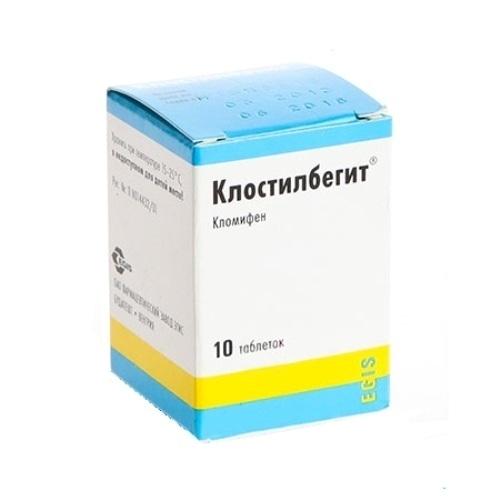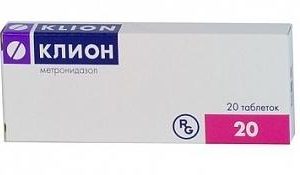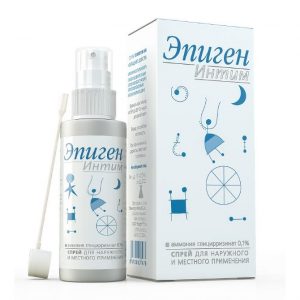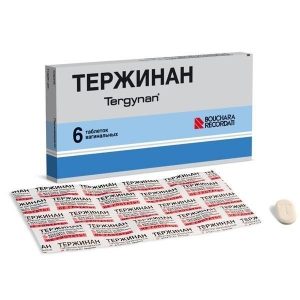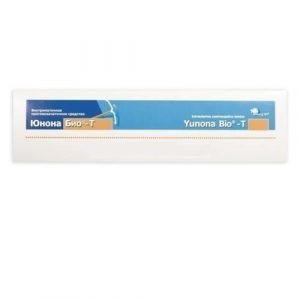Description
Packaging
In a dark glass vial 10 tablets. In a pack of cardboard 1 bottle.
Pharmacological action
Clostilbegit is an anti-estrogenic drug of non-steroidal structure.
The mechanism of action is due to specific binding to estrogen receptors in the ovary and pituitary gland.
With a low content of estrogen in the body, it exhibits a moderate estrogenic effect, with a high content – an antiestrogenic effect.
In small doses, enhances the secretion of gonadotropins (prolactin, FSH and LH), stimulates ovulation in high doses inhibits the secretion of gonadotropins.
Does not have gestagen and androgenic activity.
Indications
Anovulatory infertility (ovulation induction).
Amenorrhea (disgonadotropic form).
Secondary amenorrhea.
Post-contraceptive amenorrhea.
Stein-Leventhal syndrome (polycystic ovary syndrome).
Oligomenorrhea.
Galactorrhea (against the background of a pituitary tumor).
Chiari-Frommel syndrome (syndrome of prolonged postpartum amenorrhea-galactorrhea).
Androgen deficiency.
In men: oligospermia.
Contraindications
Hepatic and / or renal failure.
Ovarian cyst (except for polycystic ovary syndrome).
Tumor or pituitary pituitary gland.
Impaired thyroid function.
Adrenal dysfunction.
Metrorrhagia of unclear etiology.
Long-term or recent visual impairment.
Genital neoplasms.
Endometriosis.
Ovarian failure due to hyperprolactinemia.
Pregnancy.
Lactation (breastfeeding).
Galactose intolerance, lactase deficiency, or glucose malabsorption.
Hypersensitivity to the drug.
Pregnancy and lactation
Pregnancy and lactation are contraindicated.
Composition
1 tablet contains:
Active ingredient:
clomid srtl, srdl 50 mg srdl yellow
stearic acid,
talcum powder,
potato starch,
lactose monohydrate.
Dosage and administration of
In infertility, the dose and duration of treatment depend on the sensitivity (reaction to the drug) of the ovaries.
Patients with a regular menstrual cycle are advised to start treatment on the 5th day of the cycle (or on the 3rd day of the cycle with early ovulation or the duration of the follicular phase is less than 12 days). With amenorrhea, treatment can be started any day.
Scheme I: 50 mg / day for 5 days with simultaneous monitoring of the ovarian reaction through clinical and laboratory studies. Ovulation usually occurs between 11 and 15 days of the cycle. If such treatment does not lead to ovulation, then scheme II should be used.
Scheme II: from day 5 of the next cycle, 100 mg / day is prescribed for 5 days. If ovulation is not observed at this time, then the same scheme should be repeated again (100 mg / day). In case of ongoing anovulation, the drug should be interrupted for 3 months, and then repeat the treatment for 3 months. If the second course is ineffective, subsequent treatment with the drug is also not effective. The maximum total dose taken during each course is 750 mg.
With polycystic ovary, due to the tendency to hyperstimulation, the initial dose of the drug is 50 mg / day.
In post-contraceptive amenorrhea, the drug should be prescribed at a dose of 50 mg / day daily. As a rule, when applying Scheme I, a five-day course of treatment is successful.
Men, in accordance with the indications, are prescribed 50 mg 1-2 times / day for 6 weeks under the systematic monitoring of spermograms.
Side effects
From the digestive system: nausea, vomiting rarely – gastralgia, flatulence, diarrhea, acute abdominal syndrome, increased appetite.
From the side of the central nervous system: headache, dizziness, drowsiness rarely – slowing down mental and motor reactions, increased irritability, depression, insomnia.
On the part of the sensory organs: visual impairment (including impaired light perception, double vision, blurred contours, photophobia).
From the urinary system: increased urination, polyuria.
From the reproductive system: pain in the lower abdomen, vaginal dryness.
From the endocrine system: breast compaction, dysmenorrhea, pathological uterine bleeding, ovarian enlargement (including cystic) rarely – tenderness in the area of the mammary glands.
Clomiphene treatment increases the likelihood of multiple pregnancy, ectopic pregnancy, endometriosis, growth of existing uterine fibroids.
Cystic ovarian enlargement is possible, especially with Stein-Leventhal syndrome. In these cases, the size of the ovaries can reach 4-8 cm. In this case, you should monitor your body temperature and stop treatment as soon as it becomes biphasic.
Dermatological reactions: rarely – alopecia.
From the side of metabolism: rarely – increase or decrease in body weight.
Allergic reactions: rarely – rash, urticaria, allergic dermatitis, vasomotor disorders.
Other: sensations of a rush of blood to the face with a feeling of heat (stop after taking the drug).
Drug Interaction
those with drug gonadotropic hormones.
Overdose
Symptoms: nausea, vomiting, vasomotor reactions, sensations of blood flow to the face, impaired vision (decreased visual acuity, outbreaks, scotoma), enlarged ovaries and pain in the pelvic organs and abdomen.
Treatment: measures, aimed at removing clomiphene from the body conducting supportive therapy. Clomiphene is not available for dialysis.
Storage conditions
Store at 15-25 ° C.
Expiration
5 years.
Deystvuyuschee substances
Klomyfen
tablet dosage form
dosage form
tablets
